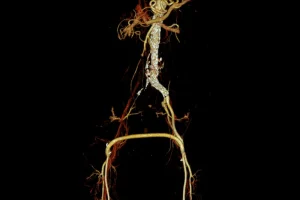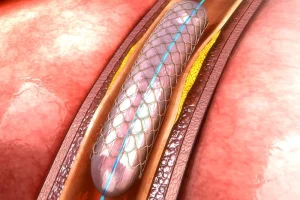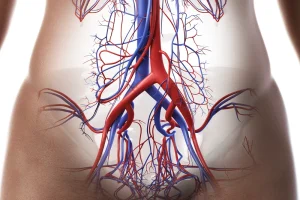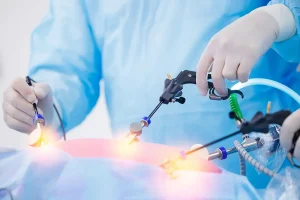Carotid Endarterectomy
The Minimally Invasive Solution For Treating Blocked Arteries
Home » Endarterectomy » Carotid Endarterectomy

The carotid arteries play a vital role in delivering oxygen-rich blood to the brain. When these arteries become narrowed or obstructed due to the accumulation of atherosclerotic plaques, the risk of stroke rises considerably. Carotid endarterectomy is a meticulously performed surgical procedure aimed at removing these obstructions and restoring proper blood flow to the brain. This intervention can prevent severe complications and support a healthier, safer life for patients.
Scheduling a consultation with our specialist doctor will help determine whether carotid endarterectomy is the most suitable option for your carotid artery health. Timely evaluation ensures that you receive the appropriate treatment to minimize stroke risk and improve overall vascular well-being.
Book an Appointment
What is a Carotid Endarterectomy?
Endarterectomy is a surgical procedure specifically designed to remove plaque deposits from the walls of the carotid arteries. By eliminating these blockages, the procedure significantly decreases the risk of stroke and restores normal blood flow to the brain.
When is Carotid Endarterectomy Recommended?
This surgical intervention is indicated in the following circumstances:
- Severe blockage of the carotid artery, typically between 70% and less than 100%;
- A history of stroke or transient ischemic attack (TIA);
- Presence of symptoms related to carotid artery disease, including weakness, numbness, or difficulty speaking.
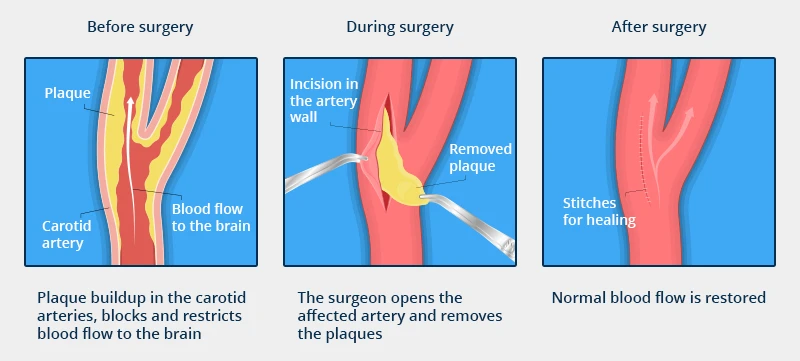
What Happens During Carotid Endarterectomy Surgery?
The procedure generally lasts a few hours and can be performed under general or local anesthesia. The main steps include:
- Making an incision in the neck to access the carotid artery;
- Removing the plaque that obstructs blood flow;
- Closing the artery and the incision with sutures.
In some cases, a temporary tube may be used during the procedure to maintain blood flow.
Postoperative Recovery
Following surgery, patients typically remain in the hospital for monitoring over a 24-hour period. During recovery, you may experience:
- Discomfort or swelling at the incision site;
- Numbness or difficulty swallowing.
Doctors generally advise avoiding strenuous physical activity for approximately two weeks and will provide guidance on when to resume normal daily routines.
Alternatives to Carotid Endarterectomy
In certain situations, a carotid stent may provide a minimally invasive alternative. This procedure involves placing a stent to keep the artery open. Your doctor will determine which treatment approach is most appropriate for your medical condition.
Preventive Measures for Carotid Artery Disease
To reduce the risk of artery blockage and stroke, the following lifestyle measures are recommended:
- Quit smoking;
- Maintain a balanced, low-cholesterol diet;
- Engage in regular exercise;
- Limit alcohol consumption;
- Schedule regular check-ups to monitor artery health.
Why Choose the VenArt Clinic?
At VenArt Clinic, patients benefit from top-tier medical expertise:
- Physicians with international experience;
- Access to advanced, safe technologies;
- Personalized treatment plans tailored to each patient’s needs.
Contacting our clinic to schedule a consultation ensures that you can explore the best options for your vascular health with experienced specialists.
Medical Team
Frequently Asked Questions
What is carotid endarterectomy?
Carotid endarterectomy is a surgical procedure that removes atheromatous plaques, which are deposits of fat and calcium, from the carotid arteries. This restores proper blood flow to the brain and prevents stroke.
When is carotid endarterectomy necessary?
It is recommended when there is severe narrowing of the carotid arteries (more than 70%) or if the patient has experienced symptoms such as TIAs or minor strokes caused by partial artery blockage.
What are the symptoms of carotid artery problems?
Symptoms may include:
- Weakness or numbness on one side of the body;
- Difficulty speaking or understanding speech;
- Blurred vision or loss of vision in one eye;
- Dizziness or loss of balance.
How is carotid endarterectomy performed?
The surgeon makes a small neck incision to access the affected artery. The plaque is removed, and the artery is repaired by suturing or with a patch. The procedure is performed under general or local anesthesia and typically takes 1-2 hours.
How long is recovery after carotid endarterectomy?
Most patients return home 1-2 days post-surgery. Full recovery usually takes 2-3 weeks. Avoid strenuous activity and follow medical guidance for wound care and health monitoring.
What preventive measures help avoid plaque recurrence?
To prevent further artery narrowing, adopt a healthy lifestyle, including:
- Quitting smoking;
- Eating a diet low in saturated fat and cholesterol;
- Regular physical activity;
- Controlling blood pressure, blood sugar, and cholesterol;
- Following your prescribed medication regimen.
Is carotid endarterectomy the only treatment option?
No. In some cases, carotid angioplasty with stent implantation may be an option. Your doctor will determine the best procedure based on stenosis severity and overall health.
How effective is carotid endarterectomy in preventing stroke?
Carotid endarterectomy is highly effective in patients with severe stenosis, reducing stroke risk by up to 65%.



